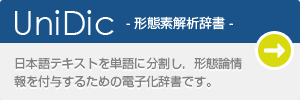Waka-shū Series: OverviewINTRODUCTION
Out of the Imperial Anthologies of Waka-shū compiled from the Heian period through the Kamakura period, here we publically release under the title "Corpus of Historical Japanese Waka-shū Series" the data of Short Unit Word and Long Unit Word for waka-shū in the anthologies known as the Hachidai-shū (the first eight anthologies).
This corpus has the following characteristics:
- In all of the texts morphological information ("reading" (pronunciation), part-of-speech, inflection, etc.) is annotated for Short Unit Word and Long Unit Word;
- Classification of the different genres within each anthology, and categories of the types of main text (introductions to poems, poems, after-notes, etc.) are annotated;
- With regard to sections with kakekotoba(a pivot word), multiple morphological annotations are supplied.
Furthermore, please note that the language in the corpus is the original language of the classical texts, and modern translations are not provided.
About the selection of texts, the anthologies and the coverage of the corpus
Main texts
The texts are based on the Nijūichidai-shū Shōho Era-print books that are items in the collection of the National Institute of Japanese Literature.
Texts selected
- Kokin waka-shū
- Gosen waka-shū
- Shūi waka-shū
- Goshūi waka-shū
- Kin'yō waka-shū
- Shika waka-shū
- Senzai waka-shū
- Shin Kokin waka-shū
About the coverage of the texts
- cover
- object information panel(daisen)
- scroll name
- kanji preface (mana-jō)
In principle the entirety of each text (kana preface, introductions to poems, poems, left-side notes) are taken as the objects of annotation. However, the following textual elements are excluded from the coverage in the corpus:
Introductory notes / Users' manual / Annotation guidelines
Please read the following abstract for this corpus before use:
- ● Overview of the Morphological Information in the Heian Period Series from the Corpus of Historical Japanese (CHJ)
- ● Annotation Guidelines for the Morphological Information in the Heian Period Series from the Corpus of Historical Japanese (CHJ)
- ● Overview of the Morphological Information in the Waka-shū Series from the Corpus of Historical Japanese (CHJ)
- ● Explanatory Notes of the Text, Display Categories for Chūnagon in the Waka-shū Series from the Corpus of Historical Japanese (CHJ)
- ● Overview of the Morphological Information of Auxiliary Text in the Waka-shū Series from the Corpus of Historical Japanese (CHJ)
Links to images of the original texts
Links from example sentences in the search results of the search tool "Chūnagon" over the data in the "Corpus of Historical Japanese Waka-shū Series" lead to pages with images of the original text containing the example sentences.
The first image link leads to facsimile images of the Nijūichidai-shū Shōho Era-print books that are items in the collection of the National Institute of Japanese Literature ("Pre-Modern Japanese Text Reader (International Image Interoperability Framework (IIIF) Curation Viewer)"). These images have been developed jointly by the National Institute for Japanese Literature and the Center for Open Data in the Humanities for online public release, and are available for reference free of charge.
As a second option, we provide an image link to page in question in the Maruzen eBook Library, a distribution service for digitized texts designed for institutions. This gives access to the text, its modern language translation, and notes. There is a charge for this service.
Note for users
Presentations of research results using the Corpus of Historical Japanese must include a citation taking the general form of the example below (with appropriate modifications depending on the version and the date of access):
- National Institute for Japanese Language and Linguistics(Matusuzaki, Yasuko, et al.) (eds.) (2022) "Corpus of Historical Japanese, Waka-shū Series"(Short Unit Word data 1.1/ Long Unit Word Data 1.1) https://clrd.ninjal.ac.jp/chj/ wakashu-en.html(accessed October 31, 2022)
* As long as one of either the version or the date of access is clearly cited, the other can be omitted, as below:
- National Institute for Japanese Language and Linguistics (2022) "Corpus of Historical Japanese, Waka-shū Series".https://crd.ninjal.ac.jp/chj/wakashu.html(accessed October 31, 2022)
- National Institute for Japanese Language and Linguistics (2022) "Corpus of Historical Japanese, Waka-shū Series"(Short Unit Word data 1.1/ Long Unit Word Data 1.1) https://clrd.ninjal.ac.jp/chj/ wakashu.html
Users will need to access the Corpus of Historical Japanese through the online search engine Chūnagon. Completion of a Users Licensing Agreement is required. Please refer to the following: The Corpus of Historical Japanese: How to apply
Development Staff
- Developers
- Matsuzaki, Yasuko(Postdoctoral Research Fellow)
- Assisting in Development
- Ogiso, Toshinobu (Professor); Kōno, Tomoaki(Assistant Professor, The University of Tokyo)
- Kondō, Asuko; WU Ning Chen; Katayama, Kurumi(Adjunct Researcher)
- Ebina, Midori; Bandō, Ryō; Hori, Asami; Nakamura, Ren(Technical Staff)
- Kikawa, Azusa; Nishio, Maiko; Watanabe, Ayumi(Production assistants)
- Joint Researchers
- Fujiike, Yumi(Associate Professor,Tamagawa University)
* Titles are current with the time of development.
The corpus compilation was supported by the "Construction of Diachronic Corpora and New Developments in Research on the History of Japanese" (2016-) project, and JSPS KAKENHI Grant Number JP15H01883 (2015-2019).

